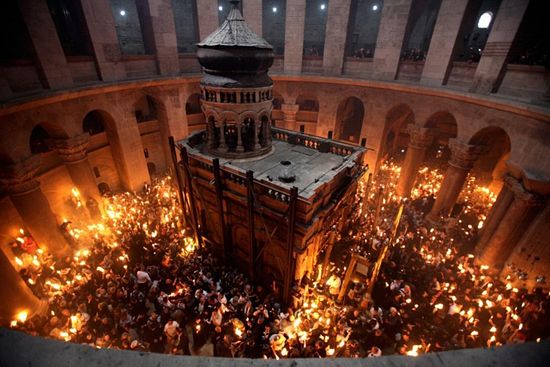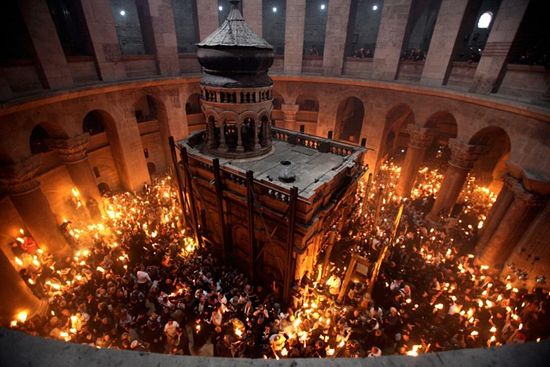
The Church of the Holy Sepulcher
The Armenian Apostolic Orthodox Patriarchate of Jerusalem – 22/3/17
Almost for 2000 years the Church of Holy Sepulcher, known as the Church of the Tomb of Christ, has been the holiest place in Jerusalem for Christians. Historically, Constantine the Great was the first Emperor who, in the middle of the 4th century, initiated building Churches for Christians. The Holy Sepulcher was one of those sacred sites that the Emperor built. Later, the Crusaders changed the Constantine construction style to a much larger one, which relatively resembled to what we see today, encompassing the Tomb of Christ, the Crucifixion site and the Discovery of the Cross site. Later the Crusaders’ Sepulcher Church was destroyed several times during the past centuries by invaders; however it was rebuilt again and again.
The ownership of the Church during the centuries has also gone through changes. Today the ownership is in the hands of three major Christian denominations, namely, the Armenian Patriarchate of Jerusalem, the Greek Orthodox Patriarchate of Jerusalem and the Franciscan Order of the Catholic Church, known as the Custody of the Holy Land. Today, these three major Churches function under the provisions of an adopted Status Quo, prepared during English Mandate in 1929 by the District Officer of Jerusalem, L. G. A. Cust. Under this status quo and verbal “traditions,” the activities, renovations, changes, etc., within and immediate surroundings of the Holy Sepulcher, are governed and decided by unanimous agreement.
The Church is described as having several holy sites within. The ownership of these sites can be explained as: a) areas (sites) that belong to each individual Church owner; b) areas that are owned by the three Churches together, as common areas to the three owners. However, there are two other Churches, the Coptic and Syrian, known as the followers of the Armenian Church, which have only certain rights, but not ownership, to conduct religious services at designated days and times. The areas where these two Churches conduct their services belong to the Armenian Church. The Abyssinian (the Ethiopian) Church, also being as a follower of the Armenian Church, it occupies the area on the roof of the Armenian St. Helena Church of Holy Sepulcher.
The Holy Sepulcher has gone through many changes during the times. In 1808 a big fire destroyed the wooden parts of the Church, mainly the dome of the Church and the Holy Aedicule (the Tomb). In 1927 a heavy earthquake hit the Church damaging its structures. At that time with the help of the English Mandate, the damaged structures, the columns, walls and arches were immediately strengthened.
In 1960s the two Patriarchates and the Custody, with unanimous agreement decided to have a major renovation, which included the dome, most of the large columns, walls, arches, and altars. These renovations lasted till the middle of 1990. During these restorations, the Aedicule for some reasons was not considered for repair.
Since responsible major communities were concerned about the stability of the Church, they, in the past, allowed some surveys to be conducted for the safety and well-being of the physical condition of the Church. There were surveys carried out in 1982 by Father Corbo, in 2000 by Martin Biddle and in 2007-8 by University of Florence, Italy. The survey of the University of Florence, in its report, assured that the foundations, the arches and the walls were strong enough to stand firm during an earthquake, except the Aedicule that required for further studies.
In February 2015 the Antiquity Department of Israel brought to our attention that the Aedicule needed some enforcement before it became further dangerous for people visiting the Church, because some of the surface stones of the lower part of front walls were displaced from their original position. So after few meetings and deliberation, the three heads of the Church agreed by the suggestion of Greek Patriarchate to invite the experts from National Technical University of Athens to conduct a survey and to suggest the best rehabilitation work for the Aedicule.
The complete survey was presented by the end of January 2016. So in March 22, 2016, the result of the presented survey was accepted and an agreement was signed by the three major Churches – His Beatitude Archbishop Nourhan Manougian, Armenian Patriarch, His Beatitude Archbishop Theophilos III, Greek Patriarch, and former Franciscan Custos, Father Pierbattista Pizzabella (presently, the Apostolic Administrator of the Latin Patriarchate – with the same University of Athens to start the rehabilitation works right after the 2016 Easter. The cost of this renovation was budgeted 3.3 million Euros, which would be equally divided between the three Churches. But for some technical reasons, the restoration was delayed for couple of months and was commenced at the beginning of July, and the completion of restoration work was scheduled within ten months.
The restoration work went smoothly without any problems or accidents, for which we are happy and thankful to God. The restoration work was supervised and coordinated by Mrs. Antonia Moropoulou, Professor of the University and Vice President of the Technical Chamber of Athens. The surface stones of outside walls were removed, cleaned and treated with safe chemicals in order to last for a few more centuries. The scraps and broken stones with old mortars behind the surface stones were removed and replaced with new ones. The original cleaned surface stones were put back in their places. The heavy iron bars which stood against and around the walls from outside were taken down. Now the only thing that a visitor will see is the shiny walls with their original pink color.
Some pictures, taken by penetrating cameras, revealed few vague items inside the Tomb. So it was decided to open the actual Tomb of Christ. On October 26, 2016, at the presence of clergy from three denominations, the surface white marble was pulled back enough to show the partial rock of the Tomb where Christ was buried (This cover has not been opened for least two hundred years). The cover marble was placed back to its original position as it was before.
When the walls of Aedicule were opened, on the southern section, in the thick wall, it was revealed the original white rock that was around the Tomb that was kept covered inside the wall in 1810, when the present Aedicule was built. By agreement, this partial rock now is kept visible under a glass window on the inside wall of the Tomb chamber.
Now the three major Churches have already prepared an opening ceremony of the Aedicule to be conducted on March 22, 2017. Heads of governments, dignitaries, political leaders, religious leaders, donors, architects with the working crew and the public are invited to attend and witness the magnificent work that was done on the Aedicule, the Tomb of Christ.
Father Samuel Aghoian


[…] Source link […]
824614 277918A thoughtful opinion and suggestions Ill use on my internet page. Youve clearly spent some time on this. Well carried out! 155663